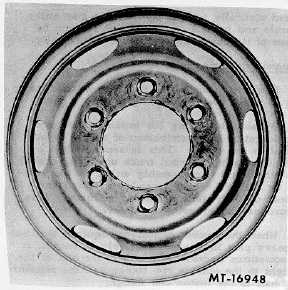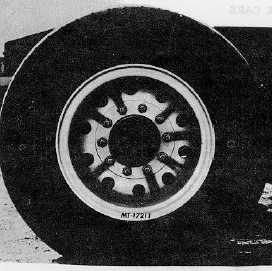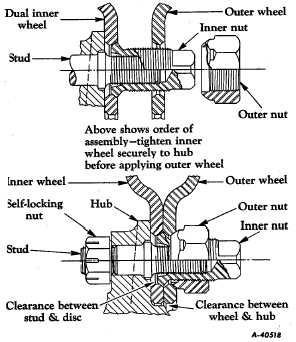|
| |
TRUCK SERVICE MANUAL
TM 5-4210-230-14&P-1
WHEELS, RIMS, TIRES
Fig. 7
NOTE: Rust streaks (Fig. 8) from stud holes is a good
indication that mounting nuts are not tightened to the specified
torque.
Fig. 8
DISC WHEELS
On disc wheels, which have rims integral with the
wheel itself, the important thing to note is that the wheel stud
nuts must be kept tight. This means they should be inspected
and tightened at regular intervals. When checking the
mounting studs and nuts on dual disc wheels,
(Fig. 9) the outer nut should be backed off before attempting
to tighten the inner nut. Try all cap nuts after the first trip or
any wheel change. Properly installed they should remain tight
indefinitely. On cast wheels which have rims that are
demountable with the tire, the rim clamp nuts should also be
kept tight. Rim and tire to wheel alignment should be checked
frequently to make sure the tire is running true. Left-hand
thread nuts can be identified by the small groove machined
around the flats. Left hand studs can be identified by the
letter "L" stamped on the head. Use left-hand nuts on the left
side of the truck.
Fig. 9
NOTE: Before mounting wheel assemblies on vehicle
make sure all parts are clean and free from foreign matter.
Excess paint on wheel stud hole perimeters can permit wheel
mounting nuts to loosen with use.
RIM TIGHTENING AND ALIGNMENT
When installing demountable rims, be certain stud
threads are clean to permit correct torquing of nuts. NOTE:
Do not use any type of lubrication on threads except when
installing aluminum wheels.
With rims in position (valve stem 180 degrees apart)
successively tighten opposite nuts to assure drawing wheel
(or wheels in evenly. This procedure will also minimize wheel
mis-
CTS-2032N Page 3
PRINTED IN UNITED STATES OF AMERICA
|



